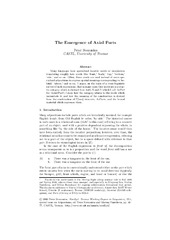The Emergence of Axial Parts
| dc.contributor.author | Svenonius, Peter | |
| dc.date.accessioned | 2009-06-04T11:31:16Z | |
| dc.date.available | 2009-06-04T11:31:16Z | |
| dc.date.issued | 2006 | |
| dc.description.abstract | Many languages have specialized locative words or morphemes translating roughly into words like ‘front,’ ‘back,’ ‘top,’ ‘bottom,’ ‘side,’ and so on. Often, these words are used instead of more specialized adpositions to express spatial meanings corresponding to ‘behind,’ ‘above,’ and so on. I argue, on the basis of a cross-linguistic survey of such expressions, that in many cases they motivate a syntactic category which is distinct from both N and P, which I call AxPart for ‘Axial Part’; I show how the category relates to the words which instantiate it, and how the meaning of the construction is derived from the combination of P[lace] elements, AxParts, and the lexical material which expresses them. | en |
| dc.format.extent | 259627 bytes | |
| dc.format.mimetype | application/pdf | |
| dc.identifier.citation | Nordlyd. Tromsø University working papers on language & linguistics 33(2006) nr. 1 s. 49-77 | en |
| dc.identifier.cristinID | FRIDAID 367514 | |
| dc.identifier.issn | 0332-7531 | |
| dc.identifier.uri | https://hdl.handle.net/10037/1877 | |
| dc.identifier.urn | URN:NBN:no-uit_munin_1637 | |
| dc.language.iso | eng | en |
| dc.publisher | Universitetet i Tromsø | en |
| dc.publisher | University of Tromsø | en |
| dc.rights.accessRights | openAccess | |
| dc.subject | VDP::Humanities: 000::Linguistics: 010::General linguistics and phonetics: 011 | en |
| dc.title | The Emergence of Axial Parts | en |
| dc.type | Journal article | en |
| dc.type | Tidsskriftartikkel | en |


 English
English norsk
norsk